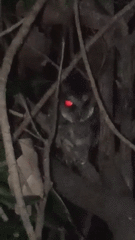Otus megalotis: taxon details and analytics
- Domain
- Kingdom
- Animalia
- Phylum
- Chordata
- Class
- Aves
- Order
- Strigiformes
- Family
- Strigidae
- Genus
- Otus
- Species
- Otus megalotis
- Scientific Name
- Otus megalotis
Summary description from Wikipedia:
Philippine scops owl
The Philippine scops owl (Otus megalotis), also Luzon lowland scops owl is a common owl, endemic to the Philippines, belonging to the family of the typical owls Strigidae. Other common names include "Otus Whitehead", "Whitehead scops owl" and "Luzon lowland scops owl". Everett's scops owl (O. everetti) and Negros scops owls (O. nigrorum) were formerly considered conspecific but are now classified as separate species.
Distinguishing features of these birds include their large upright ears from which they get their specific name megalotis, Ancient Greek for "large ears". Philippine scops owls are relatively small, sedentary birds that are naturally found in the forest understory. There are three subspecies which show variations in morphology and are distributed among different islands of the Philippine Archipelago. They are a monogamous species that offer parental care and construct their nest in tree cavities. These owls are ferocious nocturnal carnivores that feed on insects and small mammals. The IUCN Red List considers this species as Least Concern but they may be vulnerable to deforestation and fragmentation.
...Otus megalotis in languages:
- Bokmål
- Storfilippinerugle
- Czech
- výreček filipínský
- Dutch
- Filipijnse Dwergooruil
- English
- Philippine Scops-Owl
- Finnish
- filippiinienpöllönen
- French
- Petit-duc de Luçon
- German
- Philippinenhalsbandeule
- Hungarian
- fülöp-szigeteki füleskuvik
- Italian
- Assiolo delle Filippine
- Portuguese
- mocho-d'orelhas-filipino
- Portuguese
- mocho-de-orelhas-filipino
- Portuguese
- Coruja-das-filipinas
Images from inaturalist.org observations:
We recommend you sign up for this excellent, free service.
Parent Taxon
Sibling Taxa
- Otus alfredi
- Otus alius
- Otus angelinae
- Otus bakkamoena
- Otus balli
- Otus beccarii
- Otus brookii
- Otus brucei
- Otus capnodes
- Otus collari
- Otus cyprius
- Otus elegans
- Otus enganensis
- Otus everetti
- Otus frutuosoi
- Otus fuliginosus
- Otus grucheti
- Otus gurneyi
- Otus hartlaubi
- Otus icterorhynchus
- Otus insularis
- Otus ireneae
- Otus jolandae
- Otus lempiji
- Otus lettia
- Otus longicornis
- Otus magicus
- Otus manadensis
- Otus mantananensis
- Otus mauli
- Otus mayottensis
- Otus megalotis
- Otus mendeni
- Otus mentawi
- Otus mindorensis
- Otus mirus
- Otus moheliensis
- Otus murivorus
- Otus nigrorum
- Otus pamelae
- Otus pauliani
- Otus pembaensis
- Otus podarginus
- Otus rufescens
- Otus rutilus
- Otus sagittatus
- Otus sauzieri
- Otus scops
- Otus semitorques
- Otus senegalensis
- Otus siaoensis
- Otus silvicola
- Otus socotranus
- Otus spilocephalus
- Otus sulaensis
- Otus sunia
- Otus tempestatis
- Otus thilohoffmanni
- Otus umbra














